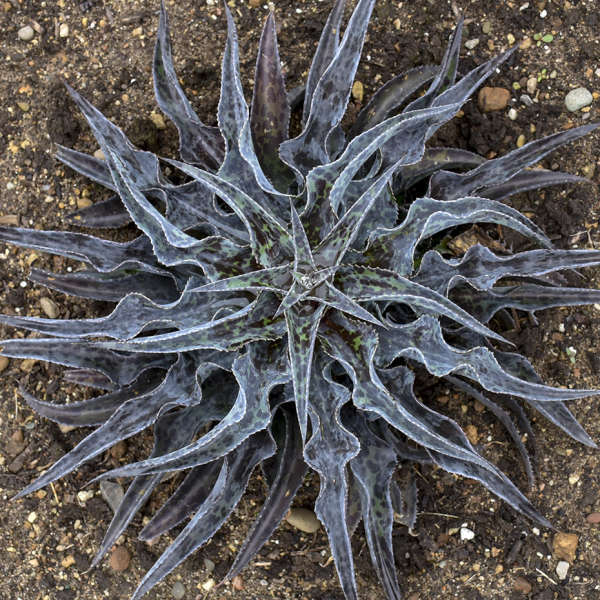Mangave (x Mangave)
Sometimes two great things come together and mix—like chocolate and peanut butter—or, in the horticulture world, the relatively recent commingling of Manfreda and Agave to create the visually appealing Mangave. If you’re like me and love to discover exotic-looking new plants to introduce into your garden, you’ve come to the right place.
Interest piqued? Please keep reading to learn more about the magnificent Mangave:

The Mangave origin story starts in the 90s, when some nurserymen in Texas collected seeds from a Manfreda to propagate and soon discovered that two seedlings were five times bigger than normal. These seedlings sported spots like a Manfreda but had the structure of an Agave. The men realized that Agave celsii grew in the next valley and the two plants had mingled and made a love child. This discovery prompted more crossing and tests to create plants with more color and different spots and freckles, and that’s why now these unique plants are available to the home gardener.
Mangaves are still a mildly obscure group of plants but are quickly gaining attention as creative plant hybridization continues, especially through the leading breeder of Mangaves, Hans Hansen of Walter Gardens, who has now made thousands of crosses and chosen the most exotic traits to create the most interesting varieties.
Mangaves resemble Agaves in their bold architectural form, but the real magic comes from its Manfreda parent that gives the plant the purple spotted pigment. Now you can find varieties with red freckles, stripes and unique leaf edgings. Both parents passed on their low-maintenance and drought-tolerant attributes, but also their dislike for excess moisture in the winter (though they can take more water than most succulents). Another cool thing about these plants is that unlike some Agaves, these plants don’t perish after flowering.
Truly the best place for a Mangave is in a pot, as they tolerate confined conditions. Plus, being in a container provides you with the flexibility to move them around the garden to find the right sun exposure and allows you to conveniently bring them indoors during the winter if you live where freezing temperatures occur.
This leads to the main downside of Mangaves, which is that that they aren’t extremely winter hardy. While some varieties are more cold-hardy than others, most survive in USDA Zones 8 to 11, and tolerate brief stints of light frost. If you live outside of these zones, definitely plant these beauties in containers so that they can take a winter vacation in the brightest room in your house.
For some serious eye-candy, check out madaboutmangave.com.
Cheat Sheet

- Mangaves, with their small, compact habit, exotic colors, and striking leaf patterns, look perfect in smaller pots as the solo star.
- They can multitask and be all things, like the central thriller or spiller in a pot, or even a dramatic filler in a frost-free garden bed.
- While you might think this plant would look stellar living indoors year round, the bummer news is that likely your plant will lose its signature bright coloring without sufficient UV light.
- Hummingbirds are especially attracted to the flowers, but deer and rabbits, luckily, leave these plants alone.
- The spines have softened through cross-breeding so these plants are way less painful to plant than some wicked agaves.
Keep it Alive

- Mangave tolerates more shade than most Agaves and if placed in a too sunny spot combined with low water, the leaves can burn. The ideal spot receives morning sun or part sun, keeping away from hot afternoon sun. If your plant loses its coloring and speckles, then it’s not receiving enough light.
- Make sure if you plant your Mangave in a container that it has drainage holes. Also, use a gritty, well-draining cactus soil. If you’re planting it in the ground, amend your existing soil with sand, perlite, pumice, or lava rock.
- Luckily these plants are not heavy feeders and can thrive in nutrient-poor soil.
- Water your Mangave regularly while it gets its roots established. If you are generous with your watering (but don’t drown it), your plant will grow much faster. Once your plant reaches its desired size, dial your water schedule down to a deep soak when the soil seems dry. Pro Tip: make sure to water only the soil and never the leaves so the sun doesn’t magnify water droplets leading to leaf burn.
- You can make more Mangaves by propagating the pups that emerge from the base of the plant. Gently pull them off and replant.
For more succulents, see:














Have a Question or Comment About This Post?
Join the conversation (0)